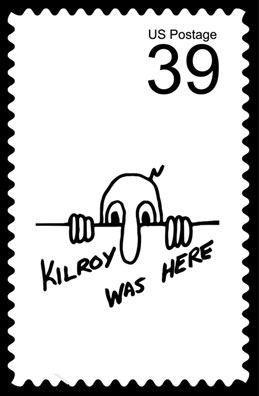Kilroy Was There



You don’t see them much anymore. It was a different time when the bald headed, big, nosed cartoon character peering over a fence could be found virtually on any surface it could be drawn on. The accompanying proclamation, "Kilroy was here," left many scratching their heads and wondering who this extensive world traveler could be.
The graffiti began appearing during World War II and there are countless theories of who he was and how the tradition got started. Some are more credible than others. The earliest sightings began in late 1939, usually on military docks and ships. An article in a December 1946 issue of the New York Times cited James J. Kilroy, a welding inspector at the Bethlehem Steel shipyard in Quincy, Massachusetts, as the one responsible for getting the fad started.
Most inspectors would mark work they had inspected with a small chalk mark. However, welders found it easy to erase these marks in order to get paid twice for the same work. When Kilroy caught on he began scrawling "Kilroy was here" on items he inspected. His markings became a common sight around the shipyard and workers thought it amusing to apply it elsewhere such as at truck stops, restaurants and public restrooms.
When these workers were drafted or joined the military, the custom went to war with them. So, during the 1940s Kilroy seems to have practically been everywhere with thousands of soldiers putting the immortal phrase wherever they went. It wasn’t so much what they wrote that made an impression, but the places it turned up. Such places as the Statue of Liberty, the Marco Polo Bridge in China and New York’s George Washington Bridge are said to have been marked with it.
Perhaps what fueled its proliferation was the competition it generated in trying to be the first to discover a place Kilroy hadn’t already been. Airmen had contests to beat Kilroy to places around the globe. However, the practice wasn’t limited to use by military men. Apparently Kilroy was also a bit of a scamp as newspapers sometimes carried stories about pregnant women arriving at a maternity ward with "Kilroy was here" emblazoned on their stomachs.
There’s a story that made the rounds in July 1945 involving a summit meeting of the Big Three in Potsdam, Germany. According to the story, Truman, Attlee, and Stalin had had exclusive use of a private men’s room. Stalin was apparently first to visit the facility. Exiting the bathroom he immediately cornered one of his aides and engaged him in an excited conversation. A translator overheard Stalin ask, “Who is Kilroy?”
It’s interesting to note, the cartoon portion had been around several years before the "Kilroy was here" part was added. According to some researchers the character was originally British and called Mr. Chad. It was accompanied with the logo, "Wot, no ____?" The blank was to be filled in with whatever happened to be in short supply at the time. Sometime during the beginning of the war the two merged and the American version was substituted.
The mania peaked during the war. It remained popular into the 50s. As memories of the war faded into history, so did Kilroy.



